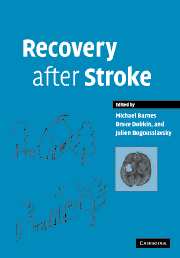Book contents
- Frontmatter
- Contents
- List of authors
- Preface
- 1 Stroke: background, epidemiology, etiology and avoiding recurrence
- 2 Principles of recovery after stroke
- 3 Regenerative ability in the central nervous system
- 4 Cerebral reorganization after sensorimotor stroke
- 5 Some personal lessons from imaging brain in recovery from stroke
- 6 Measurement in stroke: activity and quality of life
- 7 The impact of rehabilitation on stroke outcomes: what is the evidence?
- 8 Is early neurorehabilitation useful?
- 9 Community rehabilitation after stroke: is there no place like home?
- 10 Physical therapy
- 11 Abnormal movements after stroke
- 12 Spasticity and pain after stroke
- 13 Balance disorders and vertigo after stroke: assessment and rehabilitation
- 14 Management of dysphagia after stroke
- 15 Continence and stroke
- 16 Sex and relationships following stroke
- 17 Rehabilitation of visual disorders after stroke
- 18 Aphasia and dysarthria after stroke
- 19 Cognitive recovery after stroke
- 20 Stroke-related dementia
- 21 Depression and fatigue after stroke
- 22 Sleep disorders after stroke
- 23 Technology for recovery after stroke
- 24 Vocational rehabilitation
- 25 A patient's perspective
- Index
7 - The impact of rehabilitation on stroke outcomes: what is the evidence?
Published online by Cambridge University Press: 05 August 2016
- Frontmatter
- Contents
- List of authors
- Preface
- 1 Stroke: background, epidemiology, etiology and avoiding recurrence
- 2 Principles of recovery after stroke
- 3 Regenerative ability in the central nervous system
- 4 Cerebral reorganization after sensorimotor stroke
- 5 Some personal lessons from imaging brain in recovery from stroke
- 6 Measurement in stroke: activity and quality of life
- 7 The impact of rehabilitation on stroke outcomes: what is the evidence?
- 8 Is early neurorehabilitation useful?
- 9 Community rehabilitation after stroke: is there no place like home?
- 10 Physical therapy
- 11 Abnormal movements after stroke
- 12 Spasticity and pain after stroke
- 13 Balance disorders and vertigo after stroke: assessment and rehabilitation
- 14 Management of dysphagia after stroke
- 15 Continence and stroke
- 16 Sex and relationships following stroke
- 17 Rehabilitation of visual disorders after stroke
- 18 Aphasia and dysarthria after stroke
- 19 Cognitive recovery after stroke
- 20 Stroke-related dementia
- 21 Depression and fatigue after stroke
- 22 Sleep disorders after stroke
- 23 Technology for recovery after stroke
- 24 Vocational rehabilitation
- 25 A patient's perspective
- Index
Summary
Introduction
The value of evidence, as one component of the clinical decision-making process, is increasingly being accepted by rehabilitation professionals (Holm, 2000; Parker- Taillon, 2002). Clearly, it is only one component. Other important elements are the knowledge, skills, and experience of the practitioner; the values, attitudes, preferences, and expectations of the patient; as well as possible treatment constraints related to safety, time, or costs (Davidoff, 1999; Sackett et al., 2000). The focus of this chapter, however, is on the available research evidence that supports, or fails to support, ways of providing rehabilitation services or the use of specific interventions following stroke.
Stroke ranks as the sixth highest cause of burden of disease (Murray and Lopez, 1997) and is the leading condition for which people seek inpatient rehabilitation (Rijken and Dekker, 1998). It occurs frequently and often has lasting consequences. Common sequelae include motor and sensory impairments, visual problems such as hemianopia and unilateral neglect, and cognitive, emotional, and speech-related difficulties. Long-term deficits tend to limit usual activities, diminish participation in customary roles and life situations, and ultimately impact negatively on quality of life (Ahlsio et al., 1984; Mayo et al., 1999). The occurrence of stroke is, therefore, costly to persons with stroke, their families, and society. In terms of costs, it has been estimated that more than 285 billion dollars per year would be required to cover the health expenditures and loss of productivity as a result of strokes in the USA (Centers for Disease Control and Prevention, 1999). In these days of accountability and healthcare spending restraint, rehabilitation professionals must be aware of pertinent research evidence as a basis for practice. The objective of this chapter is to provide such evidence, both for and against, about the impact of different ways of organizing and delivering rehabilitation services as well asabout the value of specific physical interventions employed in treating those with stroke.
The chapter is presented in two main sections. The first focuses on the importance of how, when, where, and with what intensity rehabilitation is delivered. The second section provides information as to the value of selected treatments at various stages of recovery.
- Type
- Chapter
- Information
- Recovery after Stroke , pp. 161 - 188Publisher: Cambridge University PressPrint publication year: 2005
- 2
- Cited by



